#Wolf made me want to commit seppuku
Text
Soooo....I had an idea while trudging through a dumpster fire playing through Tactica, that idea being: What would it be like if Zenkichi (and maybe Sophia, if I decide to do that) were in Tactica?
This resulted in a two week project drawing and editing one sprite.
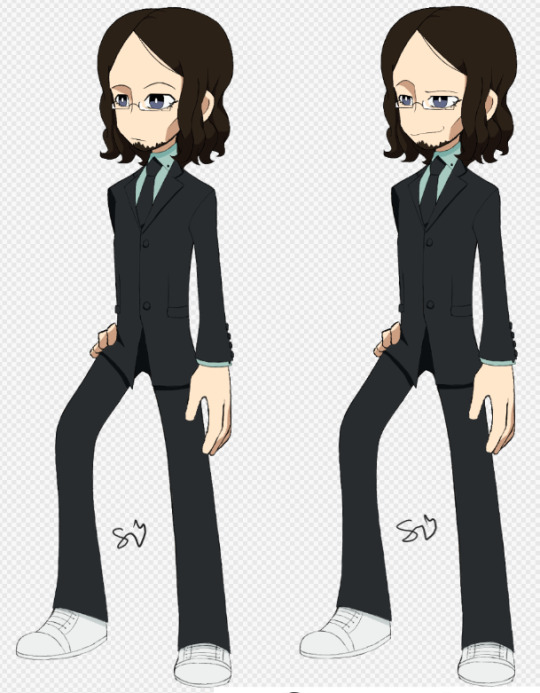
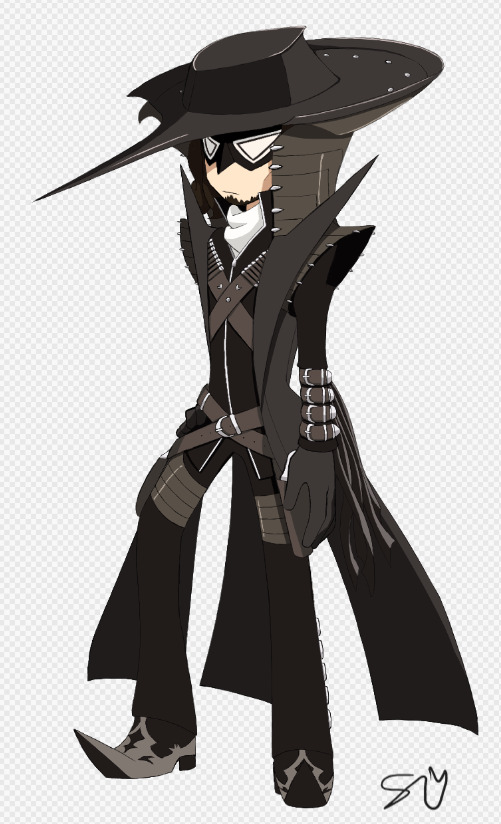


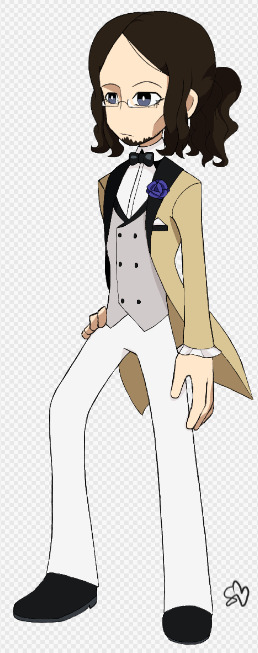
I don't know, they're decent (just not what I think is "perfect", per se), but I will do more poses and sprites if people want me to (I might even do a cut-in and promotional art replication)
(EDIT: Sorry if this post keeps changing, I keep noticing little errors the more I look at it, and have to edit it, like adding my SIGNIATURE to it! (stupid, me...)).
#persona 5#persona 5 tactica#zenkichi hasegawa#fanart#what if#Like I said I don't know if I did most of it right#Wolf made me want to commit seppuku#I also couldn't help myself and even gave him a wedding sprite for that short optional scene#Line art.....#I also apologize if some of these images are low-quality#I'm so used to screen shotting that that's what I did here
62 notes
·
View notes
Photo


Sogo Osaka Märchen Dream Rabbit Chat Part 3: Märchen Dream
Part 1 | Part 2 | Part 4 | Part 5
Sogo: Manager,
good work. I tried
to tighten my facial
muscles so Tamaki-kun
wouldn't complain about
me grinning too much at
the shoot again, but I'm
not sure how well
I did.
Tsumugi: Good
work, Sogo-san!
You were perfect!
How did you like
acting with all
12 of you?
Sogo: It was too
much for me... I was
honestly amazed by
Yamato-san's talent.
I can't believe I get
to be in a drama
with everyone like
this. I think I'll
want to commit
seppuku once it
airs.
Tsumugi: Please
don't! ><
Sogo: This is the
first time I've seen
Re:vale's acting up
close, and I must say
it was impressive.
For a moment, I even
forgot they were just
acting.
Tsumugi: Watching you
also made me feel as
if I'd actually stepped
into the world of
fairy tales.
Tsumugi: TRIGGER
played the three
villains who tried to
stop IDOLiSH7 from
returning home from
the parallel world
they were trapped in,
and Re:vale played a
mysterious pair that
wasn't allied with
either side.
Tsumugi: Even if
it's just promotion
material, I think
your drama turned out
very professional!
Sogo: Yaotome-san
tried to take over
Cinderella's world,
Kujo-san tried to take
over Snow White's world,
and Tsunashi-san tried
to take over Red Riding
Hood's world. Acting in
this was a lot of
fun.
Sogo: There was
a surprisingly
large amount of
action scenes.
Tsumugi: There
really was! When
you cut the chain
that Tsunashi-san had
put on Tamaki-san's
leg, I was wondering
what fairy tale it
was even supposed
to be from, lol
Sogo: Even though
I help Tamaki-kun in
the scene, he got
upset and told me I'm
not allowed to use
axes for some
reason.
Tsumugi: Momo-san
told me he liked
your expression in
that scene ><
Sogo: Huh...
My expression..?
Tsumugi: I-in other
words, I think he
probably thought
your performance
was good!
Choices/outcomes:
1. Was any scene particularly memorable?
Sogo: The scene where we
first meet Tsunashi-san's
Frankenstein character, maybe.
Sogo: When we wandered into
the castle, the way he popped out
of the darkness with a candle and
said "Looks like more strays
have wandered in" was so cool...
Since Tamaki-kun's bad with
horror, he was scared, though.
2. Was any scene difficult for you?
Sogo: The scene where I straddle
Momo-san and say "If you know a
way out of here, tell me"...
Sogo: I felt really bad doing
that to him, but when Momo-san
told me he was just holding back
laughter the entire time, I felt
that I'm not flexible enough.
3. Was any scene fun for you?
Sogo: The scene where I meet
Tamaki-kun's wolf character.
Sogo: In the original story,
he'd approach Red Riding Hood
because he wanted to eat her,
but in this parallel world, he
gave me a flower because he wanted
to be my friend, instead. It
was just an act, but the way
he tried to talk to me despite
not knowing how to
was kind of cute.
Sogo: Anyways,
It's good that the
shoot ended without
trouble.
Tsumugi: Right,
I already heard
from the others, but
I'm glad you had
a fun time.
Sogo: In
the waiting room,
Momo-san kept ending
his sentences with
meows, and it seems
to have caught onto
Riku-kun, so we had
a cute little incident.
Tsumugi: O-oh my!
I would've loved
to be there..!
Sogo: Since it
happened at the
dorm, I wanted to
let you know...
Everyone was in
an uproar because
Riku-kun said "Iori,
pass me the soy
sauce meow".
Tsumugi: H-how did
Iori-san react!?
Sogo: He choked on
his food and started
coughing. We gave him
some tea right away
so he wouldn't hurt
his throat, but... I
hope he's alright.
Translator’s notes..?
from a practical standpoint i can understand why every single one of these chats rehashes the basic setup & plot of the märchen drama, but from a translator’s perspective... enough
53 notes
·
View notes
Text
For Honor
This is where it all started. Before I discovered the gods from the stars, my first love in this newly discovered world of otome games were the brave men of the Shinsengumi, a group of samurai in 19th century Kyoto. It’s a funny thing how I got there. Apparently, my browser had realized that I had started to learn Japanese, and in a well-targeted add, it showed me the title picture of this particular set of stories. I have to say, I do love it when the algorithm gets stuff right. And here we are, one year and countless stories later, and yet I’ve never written about the Shinsengumi.
The truth is, I needed a break. After reading a few of the stories, I was desperate for something more frivolous, more light-hearted. The stories of the Shinsengumi are good. They are very good. But because of their very nature, they have a capacity for tragedy unmatched by titles set in the modern world, for example. Death is possible every time the men set foot outside the compound; and when they come back alive, there’s still no guarantee that they will be healthy in body and mind. If, like me, you get emotionally invested in characters, that really takes a toll.
But it’s been a year, and I thought I’d pay a visit to my favorite samurai (I know, they are technically ronin, themselves). Maybe with some light-hearted holiday fluff? But first, obviously, I owe you an introduction.
What’s the Story?
Kyoto, 1863.
After the untimely death of her father, a doctor, the MC takes over running his clinic. While not fully trained, she is able to make simple remedies, using her father’s notes and journals for guidance. One day, a young man she’s never seen before stops by the clinic to have a minor wound treated. Overhearing the patients in the waiting room talking about a band of ronin who are supposedly in town, the man advises the MC to be careful “around those wolves”, lest she be devoured. When she chides him, he apologizes for his thoughtless words and is on his way.
A stranger at the clinic…
A chance encounter in the streets…
Are we surrounded by wolves?
That very same evening, the MC comes across an errand boy being accosted by just such a ronin. Being who she is, she is ready to rush into the situation, even though the ronin is armed. Fortunately, a casually dressed stranger steps in and defeats the ronin. As he runs for his life, the ronin shouts something about wolves. Could this stranger be one of the wolves the young man at the clinic mentioned?
When the MC tells her friend Oryo what happened, and how she was saved by a “wolf”, Oryo is shocked. She tells the MC that, of all the ronin in the area, those wolves are the worst ones. They dress in pale blue coats with a jagged white pattern on their sleeves, and they apparently loot and pillage their way through town – or so she heard from a customer. Another man standing nearby, reassures the women: those wolves will soon be expunged from this world; peace will come once again.
That night, as the MC is poring over her father’s books, several ronin break into the clinic. They are looking for a place to hide, since they are being pursued. Despite blowing out the candles, it is not long before the men who are after them find them. They are all wearing sky blue coats with a white, jagged pattern on their sleeves… As the newcomers fight the ronin in the MC’s house, a fire breaks out. The MC, who had made it outside, runs back into the flames to save her father’s medical journals. As she loses consciousness, she feels that she is lifted from the ground.
This slideshow requires JavaScript.
The MC comes to in an unfamiliar room. Beside her, a man is sitting, apparently watching over her. He gives her a change of clothes, and one of her father’s journals that he was able to save from the blaze. It is thus that she is formally introduced to the men in the blue coats: they are the Shinsengumi, an elite police squad under the patronage of the Aizu clan, come from distant Edo to provide protection to the shogunate, and root out the lawless ronin that have been terrorizing the city. Since her house was burnt to the ground by the ronin, Kondo, the commander of the Shinsengumi, asks the MC to stay with them. She has nowhere else to go, and they could use the assistance of a fledgling doctor. Also, the Chōshū – the ronin sowing terror in the city – know her face, so, it turns out, it is actually in her best interest to remain under the protection of the wolves…
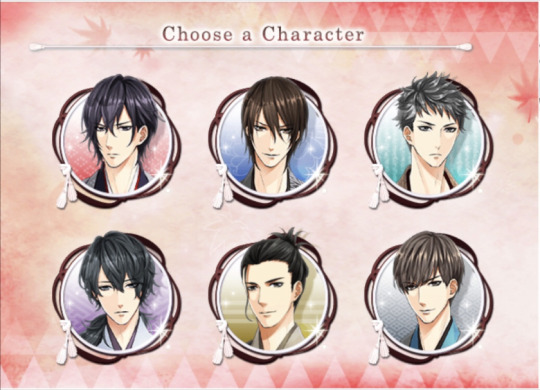
Left to right, top to bottom: Hijikata Toshizo, Okita Soji, Harada Sanosuke, Saito Hajime, Kondo Isami, Takasugi Shinsaku
The Guys
Hijikata Toshizō, also known as “the Demon Deputy” is a harsh man. As Kondo’s second in command, he supervises the Shinsengumi with iron discipline. There is, however, a softer side to him, for he likes to gaze at the moon and write poetry.
Okita Sōji, renowned swordsman and a bit of an ass, is as fierce in battle as he is irreverent outside of it. He is charming and surprisingly good with children, who love hanging out with him. He generally gets on well with people. It’s a good thing they don’t know he comes home every night, drenched in blood.
Harada Sanosuke is a tall, forbidding, and taciturn young man. He wants nothing to do with weaklings, and by extension, with women, since they are weak. His opinion on the latter is, as we can imagine, subject to change. So much so, that he puts his life on the line to save the MC.
Saitō Hajime is one of the best swordsmen in existence, which is notable especially since he is left-handed. He is also a blank canvas, a man with no memory of who he was before he was found by the Shinsengumi. What we do know is that he cannot cook to save his life.
Kondō Isami, the commander of the Shinsengumi, is an honorable, benevolent, and warm person. Nothing is more important to him than the well-being of his men, and of the citizens of the capital who have been entrusted to him.
Takasugi Shinsaku is a traitor. That is to say, he is not one of the Shinsengumi, but of the opposing Chōshū. All I know is that he is a very handsome man, as is commented upon in almost every route, but he is also the enemy, and I never considered playing his story.
Why would I date you?
You mean, apart from the fact that they are samurai? There needs to be an additional reason? Have you no honor? Okay then, how about this: these characters are men that actually existed. Yes, indeed, the Shinsengumi were real.
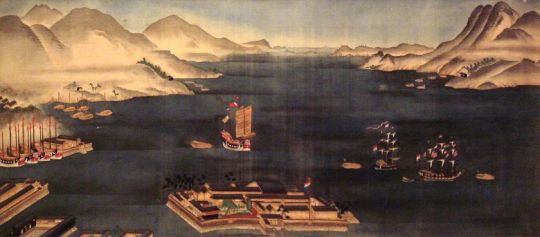
History
Since European wars have a way of spilling all over the world, an incident between England and the Netherlands in which Japan was collateral damage, led the Tokugawa shogunate to double down on its policy of “Sakoku”, closed country, which prohibited foreigners from stepping foot on Japanese land. The strictest application, which also sought to expel foreigners from Japan, remained active until 1842.
Friction arose between factions of differing philosophy regarding the usefulness of employing technology and knowledge gained from the limited exposure to foreigners the Japanese had had so far. Some argued that only traditional Japanese methods should be employed to stave off increasing foreign influence, others felt it necessary to “control the barbarians with their own methods”. In the end, it was again the white people who forced Japan’s hand, this time in the person of Commodore Matthew C. Perry, who simply threatened the Japanese with violence if they did not open up to trade.
Japanese depiction of Perry’s ship. Looks benevolent.
The results were political and economic instability. The shogunate was weakened after having had to concede in the treaties with the Americans and the Russians, which came soon after. Since the exchange rate between gold and silver in Japan was “cheaper” than in the European-controlled world, foreigners bought gold in massive amounts in Japan, thus destroying the Japanese currency and its economy. As is also the norm, the foreigners brought a heretofore unknown disease with them. Cholera wiped out several hundred thousand people.
Finally, in 1863, an Imperial Order was issued to “expel barbarians”. And while the Emperor was the head of government, of sorts, his role was understood at the time as ceremonial, much as it is today. Therefore, an order issued by the Emperor that contradicted the policy of the shogunate was… difficult. The Chōshū clan, however, immediately began to carry out the order, in open defiance of the Tokugawa shogunate. After a failed attempt by the Chōshū to restore Imperial order over the shogunate, the Tokugawa, Aizu, and Satsuma clans expelled the Chōshū from the palace.
This is when the Tokugawa gathered an elite force to patrol the capital and protect the interests of the shogunate against the Chōshū incursions. After a predecessor of the group fell apart, the Shinsengumi were formed. They then also requested permission to patrol the streets of Kyoto from the Aizu, a request which was granted.
The real Hijikata Toshizō
The Serizawa faction of the Shinsengumi, however, was more disruptive than beneficial to the capital, which is why the Aizu ordered Kondo to eliminate Serizawa and his officers. Yamanami Keisuke and Hijikata Toshizo ordered one of Serizawa’s men to commit seppuku for breaking regulations. Serizawa himself was assasinated by a small force led by Hijikata. This left Kondo as the leader of the Shinsengumi.
The showdown in the main stories of our fictional Shinsengumi is the real-life Ikedaya Incident: there, the Shinsengumi killed a group of ronin in the employ of the Chōshū, who had apparently planned to kidnap the daimyo of the Aizu clan, and set fire to Kyoto.
Kondō Isami, born in 1834, was the youngest of four siblings. The son of a farmer, he was adopted by the third generation master of the Tennen Rishin-ryū, Kondō Shūsuke, who had seen him train in his dojo. He became the fourth generation master, and took over the running of the Shieikan (the main dojo). It is there that he first met Hijikata. Kondō was known to be an avid reader and scholar. He was apprehended by Imperial forces in April 1868, and was executed by beheading on May 17th, 1868. His head was publicly displayed on a pike.
The son of a well-to-do farmer, Hijikata Toshizō was born in 1835, the youngest of ten children. It is said that he was uncommonly tall compared to the average male at the time, and he was handsome. It seems that he was also a bit of a spoiled brat when he was young. He helped in the family business of selling their Ishida sanyaku, a herbal remedy for treating bruises and broken bones. Through his brother-in-law, he was introduced to Kondō and the Shieikan. He never fully mastered the Tennen Rishin-ryū, but instead developed the “Shinsengumi-Kenjutsu” fighting style.
In the final battle of the Boshin War, Hijikata gave his page his katana, a photo of himself, a letter, a few strands of his hair, and a death poem, to be taken to his brother in Hino: “Though my body may decay on the island of Ezo, my spirit guards my lord in the East.” On June 20th, 1869, he died by a gunshot wound sustained while leading his men into battle.
Okita Sōji‘s older sister Mitsu was adopted by Kondō Shūsuke, so that she could marry the adopted son of the Okita family. This is, of course, the same man who had adopted Kondō Isami. Okita started training at the Shieikan at the age of nine. He was unusually gifted, and had mastered all the techniques by age 18. He was born in 1842 or 1844, which made him one of the youngest recruits of the Shinsengumi. He is described as charming and polite, but also as strict as an instructor of kenjutsu for his students. He was appointed by Kondō to become the fifth generation master of the Tennen Rishin-ryū. Okita developed a signature technique, called “Mumyo-ken”, which could attack the opponent’s neck, left shoulder, and right shoulder in one motion.
Okita was hospitalized during the Boshin War, and when the shogunate forces retreated, he stayed behind in Edo in the care of his sister Mitsu. He died of tuberculosis on July 19th, 1868, at the supposed age of 25.

Nihonbashi bridge in Edo
Harada Sanosuke was born in 1840 into a family of chūgen: better than commoners, but less than samurai. He was trained in the Hōzōin-ryū style, using a spear as a weapon, rather than a sword. Once, he was taunted by a higher-ranking retainer of the Matsuyama clan that, given his low social class, he didn’t even know how to properly commit seppuku. Upon which he immediately drew his sword and attempted to actually do it. The wound, however, was shallow, and Harada survived. After leaving the Matsuyama’s service, he went to Edo to train in Kondō’s Shieikan.Having left the Shinsengumi after the defeat in the Battle of Kōshū-Katsunuma, he returned to Edo, where he fought with the Shōgitai, who also sided with the Tokugawa shogunate, in the Battle of Ueno. He was severely wounded by enemy gunfire, and died two days later, on July 6th, 1868.
There is, however, an interesting rumor, that Harada did not die, but was able to flee to China, where he then became the leader of a gang of bandits on horse-back. He is also rumored to be the mysterious old man who came to the aid of the Imperial Forces in the First Sino-Japanese War in 1894/5…
Little is known about the early years of Saitō Hajime. His birthname was Yamaguchi Hajime, and his father was a foot soldier in the employ of a samurai in Edo. Saitō left Edo after accidentally killing a hatamoto (a ronin in the direct employ of the Tokugawa shogunate). He was of an age with Okita when he joined the Shinsengumi, making him one of the youngest in their ranks. Saitō Hajime was, even in real life, the dark, mysterious kind, in that he spoke sparingly. He was also known for his immaculate appearance and exemplary posture, typically sitting in the formal seiza position.
Believed killed in the Battle of Nyorai-dō, Saitō managed to escape alive and rejoin the ranks of the Aizu. However, when Aizuwakamatsu Castle fell, he, along with other Aizu soldiers, was held as a prisoner of war.
The surviving Aizu traveled to Tonami, the new domain of the Matsudaira clan of Aizu, and Saitō with them. In 1874, he returned to Edo, which in 1868 had been renamed “Tokyo”. There, he began working for the Tokyo Metropolitan Police Department. In a twist of fate, he fought, in this capacity, on the side of the Imperial Army against the Satsuma Rebellion*, former allies of the Aizu.
In 1875, he assisted in setting up a memorial for Kondō Isami and Hijikata Toshizō.
Saitō Hajime died in 1915, at the age of 72 years, in his living room, while sitting in perfectly straight seiza posture.
Takasugi Shinsaku was born in 1839 in Chōshū Domain, present-day Yamaguchi Prefecture. He was a samurai and a brilliant military tactician. In 1862, Takasugi went on a reconnaissance mission to China, to observe the effect of western influence on the country. Shocked by what he saw, he returned to Japan determined to avoid the fate of colonization.
He formed the revolutionary shotai, a militia comprised of not just samurai, but people of all classes. Apparently, everybody from farmers and merchants to sumo-wrestlers and priests could (and did) enlist. He also provided this new militia with western weapons and tactics, thus outwitting the traditional Tokugawa forces.
In the end, his approach proved successful: the Tokugawa shogunate fell in 1868, and the Meiji Restoration restored (hence the name) the Emperor to power. Takasugi, however, did not live to see the day; he died in May 1867 of tuberculosis.
* The Satsuma Rebellion was the last stand of samurai Saigō Takamori. The movie “The Last Samurai”, featuring Ken Watanabe and Tom Cruise, tells his story.
What’s with the history lesson?
What? Like this isn’t interesting? I guess not everybody gets a kick out of history, huh. What I’m quite impressed with, though, is how some of the corner-stones of the real Shinsengumi’s peculiarities were worked into the stories here. I really appreciate that, because research has clearly been done, and the stories are better for it. No, that doesn’t mean they’re historically accurate. That wouldn’t be very… romantic. But the characters are recognizable from their templates.
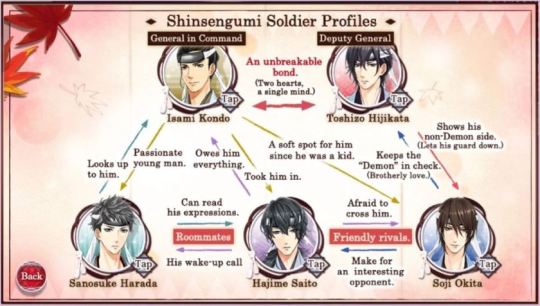
I choose you!
I’ve read the main stories of Hijikata, Okita, Saito, and Harada. And yes, we call them by their family names. Kondo was too pure for my tastes, and indeed, my friend The Librarian found his story to be rather boring. Don’t get me wrong, he is a very good man, but the vibe is more “guardian” than “lover”, I guess. All the stories are really intense, as the threat of death constantly hangs over the men. Especially Saito practically seeks it out. If you’re looking for gut-wrenching, you’ve come to the right place.
A word on our MC: I like her. As opposed to her modern-day counterparts, this girl is actually a virgin, so all the blushing has a place. What she also is, though, is courageous, and capable. She learned medicine from her father, and continued his clinic on her own after his death. She is not squeamish around blood (it’s just that sometimes, there’s a bit much of it). Actually, she is not squeamish in general. After initially being intimidated, she finds her place among those “brutes”, as Kondo calls them.
This is still one of my favorite titles. Even if it’s a bit much for my poor heart…
Era of Samurai: Code of Love A historical drama about samurai who were actually people in real life. Includes a history lesson. You're welcome. For Honor This is where it all started. Before I discovered the gods from the stars…
#Bakumatsu#Edo period#Era of Samurai#historical#Love 365#otome#otome game#Shinsengumi#Tokugawa shogunate#Voltage game
0 notes